Offgrid Transportation eMergency Transportation: eBikes Are For More Than Just Going Green
In This Article
Scenario 1: It’s 6:10 in the AM. The city you live in, which happens to be below sea level, is assailed by torrential rain and sustained winds of up to 140 mph. Sea surge of nearly 30 feet quickly overwhelms the levies and entire neighborhoods are swallowed by water. Whether you moved to safety beforehand, or decided to stay, it will take at least two more weeks before utilities are fully restored.

Above: Water can rise alarmingly quick during heavy precipitation, especially in low lying areas. Photo taken by Syed Qaarif Andrabi.
Scenario 2: It’s 1:25 in the AM. Awoken by the sudden absence of the electric hum that pervades everyday life, you look around the darkness confused. Temperatures have dropped over 40 degrees below normal for this time of year, and an overtaxed energy grid has forced rolling brownouts. Unpredictable winter weather is on the rise, and getting worse. On top of the life-threatening risk of cold exposure, it will be another nine days before all roads are fully passable.

Above: Heavy snowfall can block roads, take down power lines, and cause people to take risks they may not have otherwise. Photo by Maria Orlova.
Scenario 3: It’s 4:17 in the AM. Without warning, normal everyday life is violently upended as seismic upheaval destroys entire cities and kills tens of thousands in a matter of minutes. Maybe you were fortunate enough to be in a building constructed to code, or maybe you were far enough away from the epicenter to be spared the worst. Either way, it is going to be a long time for life to resemble what it once did.

Above: Infrastructure not built to withstand the energy of a powerful earthquake can crumble, killing and injuring any who are inside or nearby. Photo take by Aksel Anıl.

All of the scenarios above have something in common, other than the fact each occurred uncomfortable early in the morning. When disasters strike, the things we most commonly rely on disappear, sometimes indefinitely. Having a reliable source of fuel and a method of transportation is a fairly recent amenity that is often overlooked until we reach for it… and it's not there. For most, storing large quantities of gasoline, or having a partially submersible overlanding vehicle is an impractical prep, but there are alternatives. One such alternative is the eBike.
eBikes have been around a lot longer than most people realize. The first patents for hand-cranked, three-wheeled bikes without any pedals were seen in France way back in the 1880’s. But due to the financial influence of big players in the oil market, battery powered bikes remained in obscurity until over 100 years later. Which may be for the best. Old models were obscenely bulky, and lead-acid batteries large enough to move an adult were cumbersome behemoths.
As lithium-ion technology hit the market and improved the use of hand held electronics, the eBike’s practicality also received a much needed boost. Smart batteries and decreasing costs of computer components spurred more innovative eBike designs. These days, an affordable eBike can travel at ranges up to 200 miles on a single charge. Throw in pedal assist, and eBike can go as far as the endurance of the human who rides it. All this without the expense, weight or emissions of cars or trucks powered by fossil fuels.
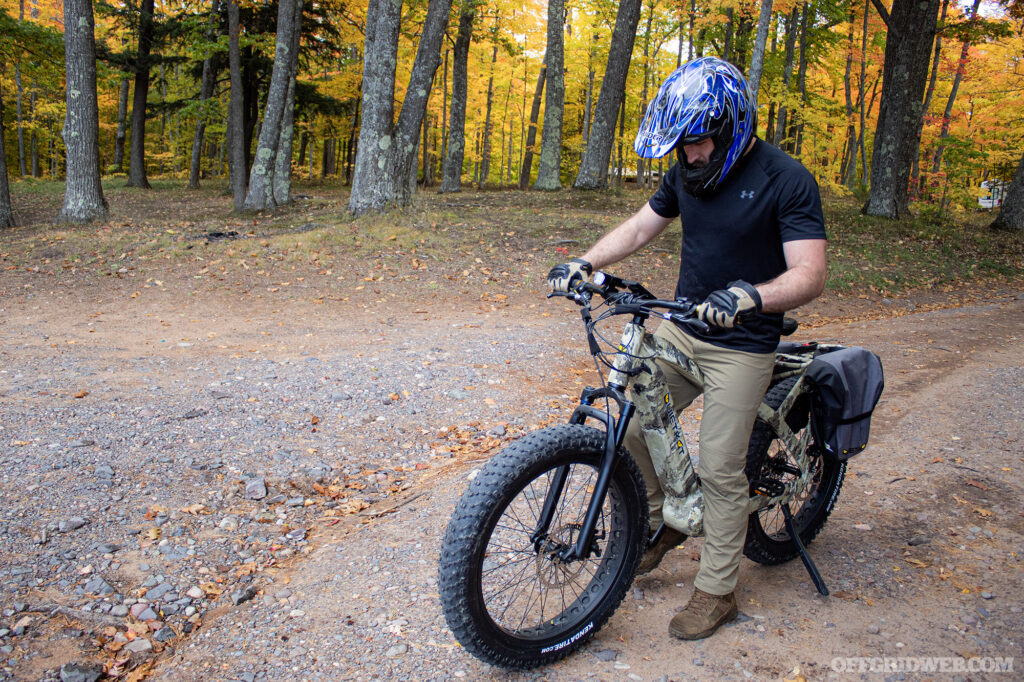
Above: Before riding a motorized vehicle, such as eBike, it is important to wear appropriate personal protective equipment and make sure the functions of the bike are working properly.
Many people use ebikes to make inner-city commutes easier and less costly. For someone in a fair weather climate, using an ebike eliminates fuel expenses, reduces insurance premiums, and where gridlock occurs, it drastically cuts down on commute times. Many newer models are even powerful enough to tow small payloads, nudging into the realm of cargo transportation with the right accessories, such as pull behind trailers and cargo racks.
Not everyone is fit enough to spend the day biking around on trails. This includes the elderly, and the physically disabled. With an eBike, the effort needed to enjoy a leisurely excursion is limited only by being able to maintain balance, and battery life. Using an ebike to get around scenic and tourist locals eliminates the need to pay for more expensive options and reduces physical exhaustion. Someone suffering from joint pain, or a leg injury can still enjoy getting around in the open air without having to torment themselves. Lightly pedaling, but letting the electric motor do most of the work, could be a great starting point for someone out of shape to build themselves up without risking injury or cardiovascular complications.
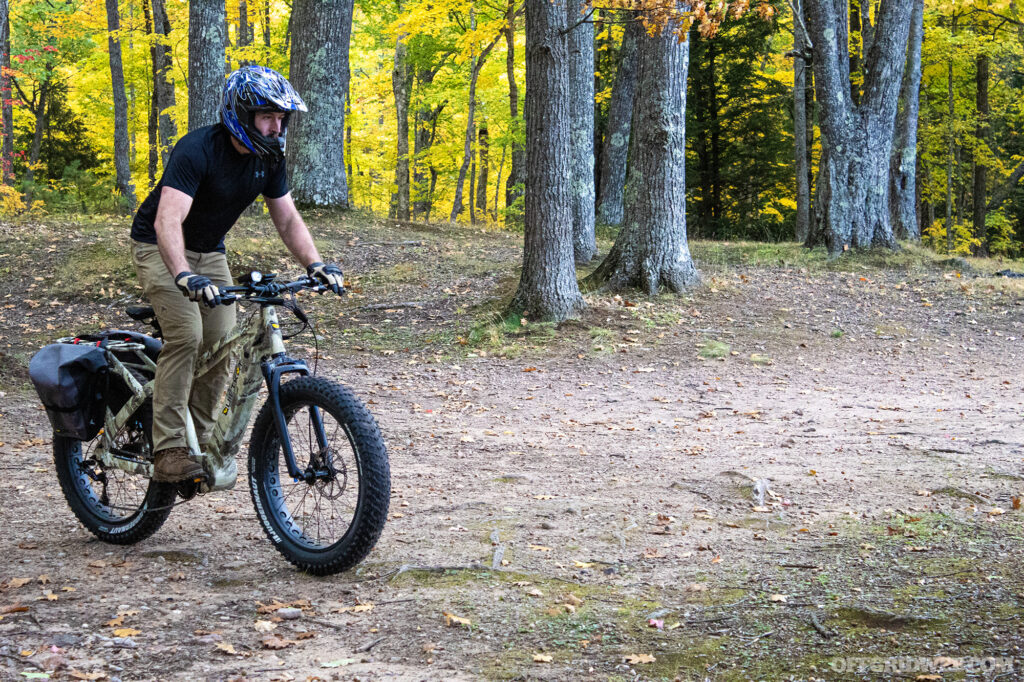
Above: Going for a ride on a smoother trail or road before taking on more challenging terrain is a great way to test the brakes and make sure the electronic motor is operating the way it should.
Many upsides to eBikes exist, but what about in an emergency situation or survival scenario? Being able to move quickly while quietly, and with little effort would be a boon when heading to a bugout location. It attracts less attention than a vehicle and is much more expedient than traveling on foot. An ebike fits into tighter spaces, making narrow alley’s and pedestrian walkways that a car or truck would never fit into, easily accessible routes. Some models are capable of off road travel, furthering versatility, especially when making the urban/rural transition. To find out if an eBike is truly up to the worst calamities Mother Nature–or human nature–can throw our way, I got my hands on one of the most rugged models out there.
QuietKat is a company that leads the way for offroading eBikes. Right out of the box, the Warrior model is an impressive specimen. Weighing in at 70lbs, 10 of which are the battery, it is readily apparent that it was built to take a beating. 26” x 4.5” All-Terrain fat tires, an adjustable coil suspension fork, and Tektro mechanical disk brakes are designed to get off the streets and do some major offroading. Several different modes allow the user to adjust the efficiency of the 5-speed motor, and it can easily reach speeds over 20 mph depending on which battery type is included. The Warrior has a load capacity of 325 lbs, a cargo shelf that can carry up to 100lbs, and is capable of towing.
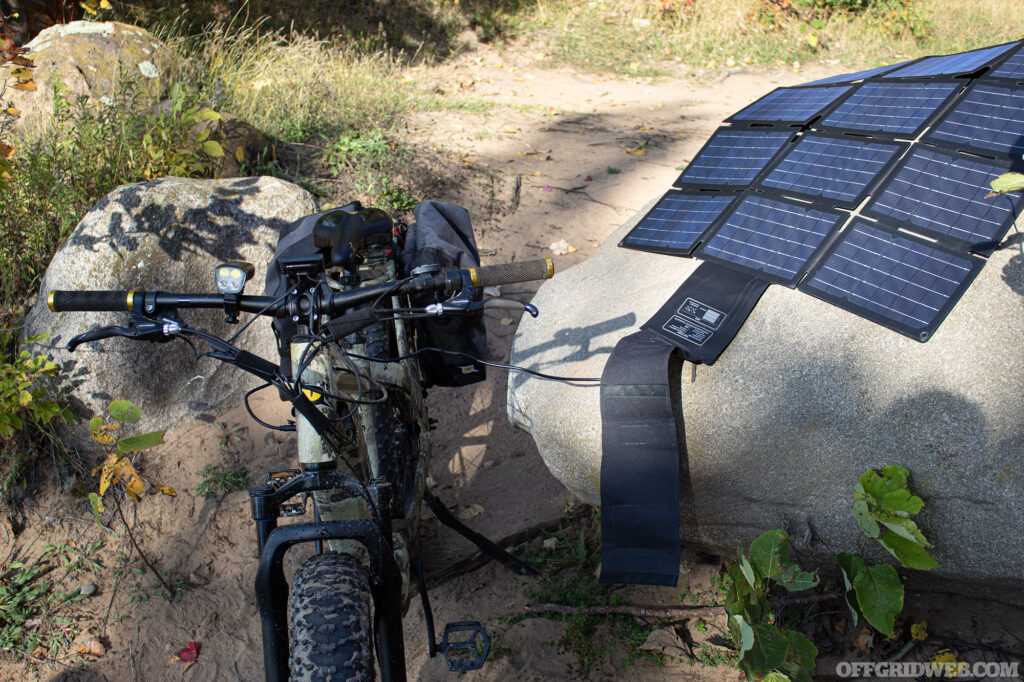
Above: The portable solar charger is weather resistant and folds into a compact size, making it easier to store in a pack.
In addition to all the techno wizardry and performance design, there are a ton of accessories that make this brand stand out from the crowd, specifically the Comfort, Overlander’s, Angler’s and Hunter’s Kits. These include numerous cargo options, seat enhancements and even an all-terrain cargo trailer for pulling game out of the woods, or supplies into it. The model I’m using is a combination of the Comfort and Overlander kits, and includes a portable solar charging station. Eager to push it to its limits and see what it’s capable of, I fully charged the warrior via its conventional 110v AC charging cable, and identified a few unique locations to run it through its paces.
Before I started throwing the eBike into challenging situations, I wanted to warm up with it on the paved roads near my house, and I’m glad that I did. If you’re like me, you might be thinking, “I know how to ride a bike, how different can it be?” Well let me tell you, there is a dramatic difference. Almost as soon as you begin pedaling, the electric motor kicks in, giving an instant speed boost. Depending on what setting you pre-programmed, this automatic motor engagement will launch you forward without much effort. If you’ve ever driven a dirt bike, or motorcycle, then you know how intertwined balance and momentum can be. 70 lbs might not sound like a lot, but it makes a huge difference when compared to a traditional 12-speed mountain bike. Fortunately the bike-riding fundamentals are largely the same, and before long I was zipping down the roads, already impressed by how much of a boost I could get with the motor. After familiarizing myself with the mechanics and the digital settings, I was comfortable ramping things up to the next level.
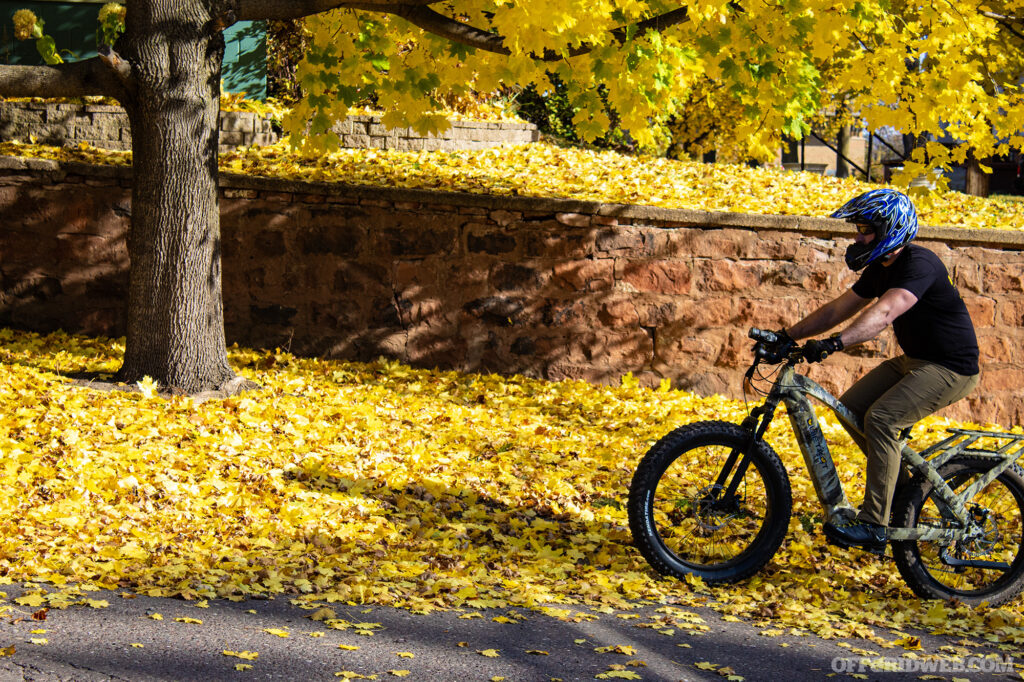
Above: The motor assisted pedaling is surprisingly effective, and it makes traversing town roads practically effortless.
On well established gravel or paved roads, an eBike seems more moped than bike. Pedals are useful, and using them will significantly boost your speed and your mileage, but you’re not putting much effort into it once the motor engages. On both gravel and pavement, I was able to max out my speed in the 25 to 30 mph range. The bike could easily keep up with in-town traffic. Going up inclines is also surprisingly easy. When the motor kicks in, minimal effort is required, even on inclines as steep as 20 degrees.
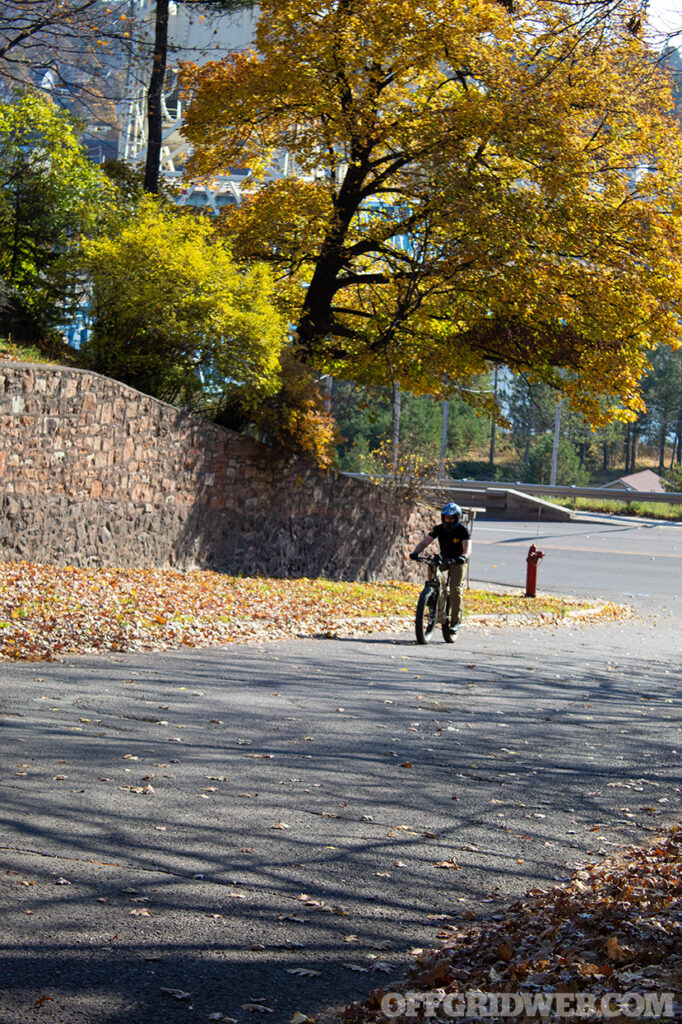
Above: Even steep roads are easily driven with an eBike's motor helping the rider.
My first offroad location was a remote camping site with rooted and rutted trails surrounding a boreal lake. To compensate for the unpredictable terrain, I loosened the suspension, and soon I was floating over downed tree branches and larger holes. This was actually surprising to me, since my only off road biking experience told me that I would be in for a bumpier ride. I was pleasantly surprised how easily I could get around, both on the trails, and even through undeveloped forest floor. Although I will warn that deciding to go off the trail means taking it slow. Being loaded down with gear adds a lot of extra weight, and the eBike the size of the Warrior is not as nimble as its non-motorized cousins. This makes tipping over easy if a corner is cut too sharply, or balance is lost trying to make it over a larger obstacle.
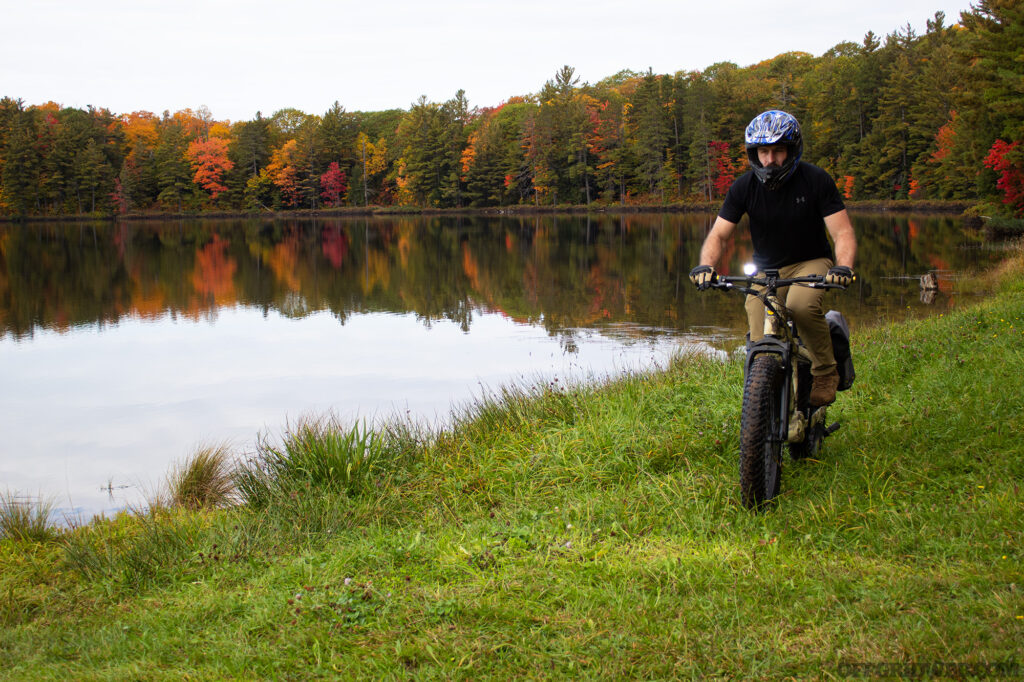
Above: Off the trail, the right eBike makes traveling through open wilderness an easy task.
Which leads me to what I consider one of its more challenging tests: deep mud. The land surrounding the lake is filled with swamps and bogs. With the ground so saturated, it is easy to step up to find knee-high mud, or deeper in some places. In this scenario, fat tires make all the difference in the world, especially when the air is let out a little ways. What I found was that by determining where the mud meets dry land, and traversing the mud in a straight line to that point, I could make it to the other side 9 times out of 10. The deeper the mud, the more speed and momentum is needed to get across. Trying to make gradual turns typically lead to wiping out, so good balance and maintaining straight-line momentum is crucial in this situation. Even so, with the combined weight of myself, my gear, and the bike, I was able to get across large mud patches without worrying too much about falling over into the goop.
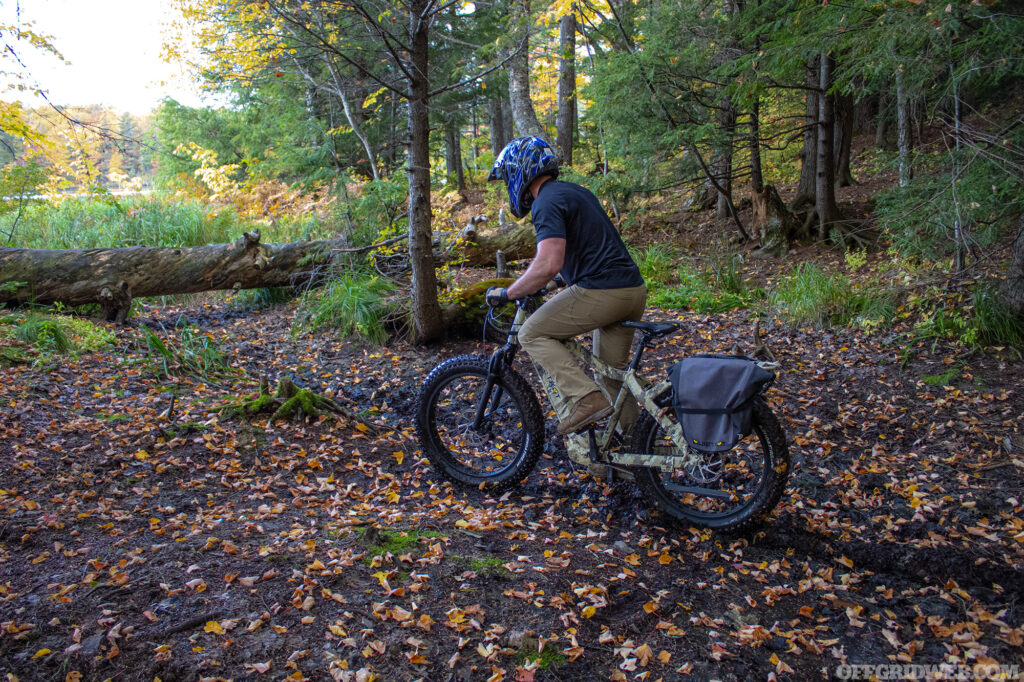
Above: Sharp turns should be avoided when traveling through deep mud. Turning too quickly causes the tires to brake in the same way a hockey player turns sideways on ice to skid to a stop.
If mud is wet and goopy, the opposite condition has got to be what people often refer to as “sugar sand”. Maybe you’ve had the unfortunate experience of trying to drive your vehicle near a beach, or through sand dunes, only to discover that loose sand has next to non-existent traction. Well that's just the terrain type for the next location. Generally, the 70lb Warrior does very well over this type of terrain. Like driving through deep mud, the best results require letting some air out of the tires. After doing so this bike was zipping down a sandy Lake Superior beach with minimal effort. Balance and momentum were easier to maintain compared to wet mud and the bike was able to make sharper turns more easily as well. The only task it could not perform was going up a steep dune with a rider on the bike. Once the bike was moving up the sandy terrain at a steep angle, the tire dug into the sand and stalled. Regardless of whether it was a weight issue, or the riders-skill, if I wanted to get to the top of the dune, I needed to get off, and engage the motor for assistance as I walked it the rest of the way.
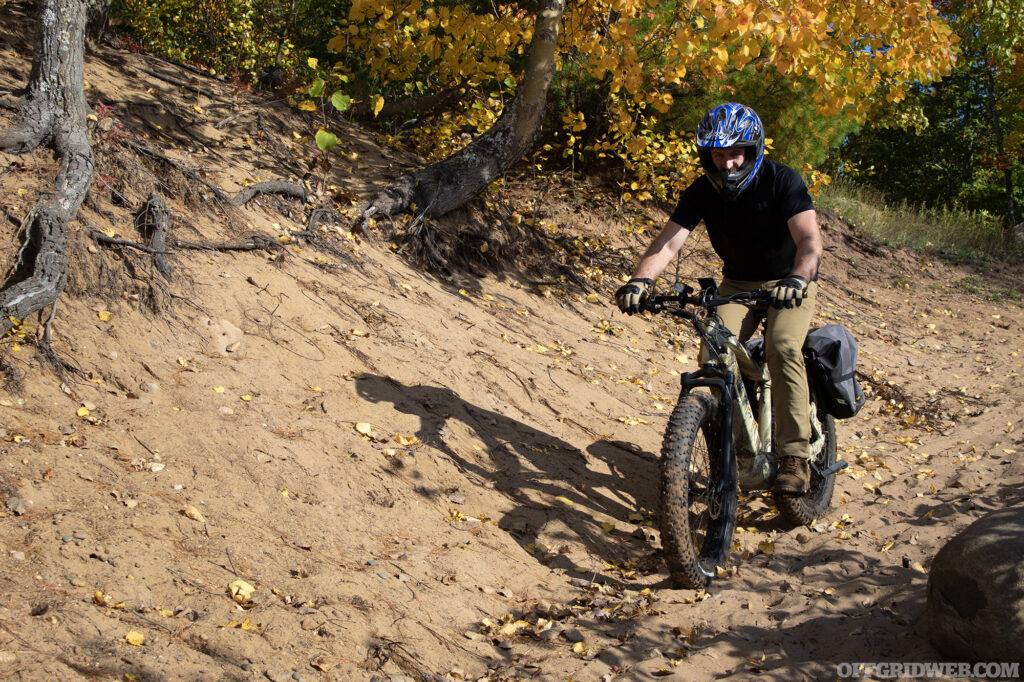
Above: The combined weight of rider and eBike proved too much to make it over steep dunes. Traveling over sugar sand was similar to deep mud.
Shallow water crossings were a breeze and did not negatively affect the performance. Water at the crossing site I tested was flowing steadily from an inland river to the lake. The bottom was lined with muddy silt, and various sizes of rocks. The weight of the bike helped keep it upright against the force of the moving water, and once again those fat tires proved their worth in this situation with much needed traction. This wouldn’t be the ideal way to cross water deeper than the tires are high, or in areas with a more forceful flow rate, but the Warrior would work great at sites that have been assessed as relatively safe. It was great to see how waterproof the components of the bike were, and being submerged did not cause the motor or the battery to malfunction.
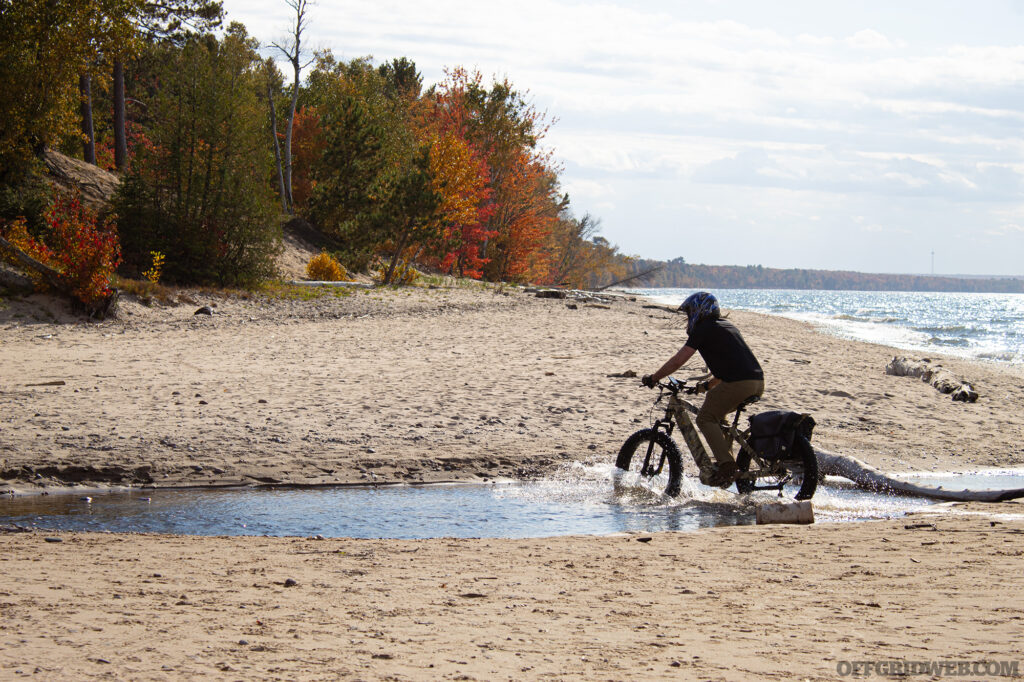
Above: Doing a quick reconnaissance is important before attempting to cross moving water to avoid falling over any underwater ledges, hitting any large rocks, or getting stopped by underwater logs.
Snow and ice have similar properties to mud and sand, and the eBike traverses them as such. Going through deep fresh powder is more challenging than dense snow pack or ice, but it will make it through. Moving in straight lines is more important in powder and on ice, but a dense snowpack is almost like moving over asphalt. Traveling fast through cold air requires additional layers to prevent cold weather injuries, but the added bulk didn’t get in the way of the pedals or chain. I did notice a slight decrease in battery longevity in colder weather, but the rate the battery drained was not alarmingly fast. Recharging times seemed pretty close in both cold and warmer conditions, with the solar panels and with the AC adapter. It took about 6 hours, give or take, to get the battery from completely drained back to fully charged.
Being much lighter and smaller than a vehicle makes an eBike a great option for travel and mobility. However, eBikes are heavier than motorless bikes, and not everyone is capable of swinging 40 to 70 pounds around when needed. Moving 70lbs of anything can be challenging if you’re out of shape, or by yourself. That being said, the bike would be relatively easy to deploy from an apartment, a garage or from the rack of a vehicle. An eBike does not emit loud engine noises or exhaust fumes, which attracts less attention, and allows the rider to have better situational awareness. Not having to rely on fossil fuels, and being able to charge with solar panels would be a huge advantage in a situation where utilities and gas stations are shut down.
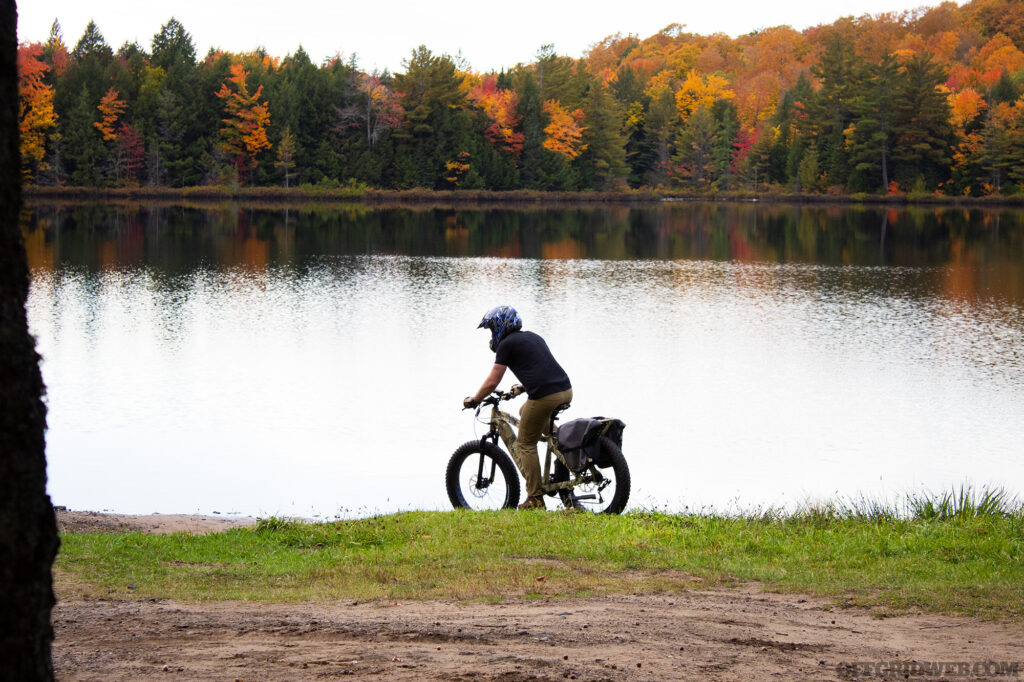
Above: While not as light an agile as a non-motorized mountain bike, eBikes take significantly less effort and can go many places mountain bikes cannot.
Sure, they are not as large as a sedan, but eBikes instantly stand out to anyone paying attention because they have features not seen on their motorless counterparts.. A model like the QuietKat Warrior looks more bulky and aggressive, and tends to draw even more eyes. The flip side of this is that a bike has a lower profile and less bulk than a car or truck, making it a smaller target, and increasing agility.
Mechanical problems could be problematic in an emergency situation. If the motor malfunctions, it is not as easy to repair as a motorless bike would be, and finding or ordering parts may not be an option. We have all experienced the effects of a disrupted supply chain, and those issues would be exacerbated in a disaster area. Other than keeping the bike maintained, having a fully charged battery could prove difficult as well. After the battery runs out of energy, the rider must pedal the extra weight until they are able to charge it again. Without working utilities, solar panels, or enough sunlight, long periods of time could pass between being able to recharge it again.
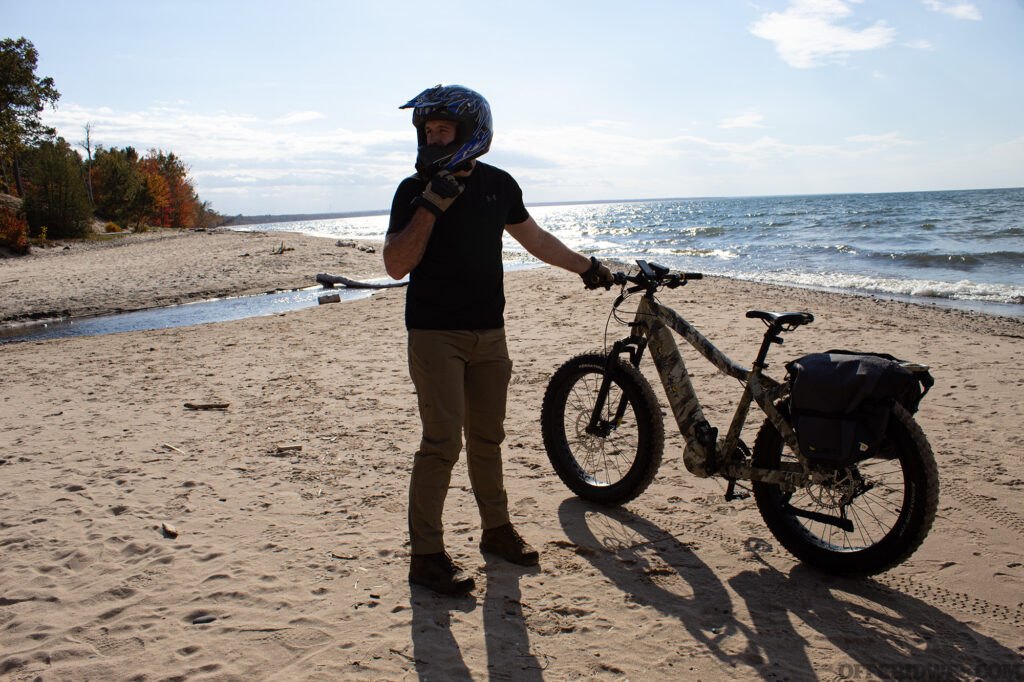
Above: Embarking off the beaten path on a bike that can go where others can't is great way to discover new areas with minimal effort.
As far as usefulness in an emergency or survival situation goes, eBikes capable of offroading would be invaluable. Before running the Warrior through various terrain, I was skeptical it would perform as well as it did. But modern eBikes are more powerful and versatile than ever before, and well worth considering as a transportation or mobility alternative, in addition to other preps. Practicing with it, knowing how to repair or maintain it, and having some back up parts could make the eBike a tool that can outlast an extended crisis period. Having a reliable method of grid-down mobility would absolutely help in each of the scenarios we considered in the beginning.
Will an eBike be a help or a hindrance? The answer to almost every survival question is, “It depends.” An ebike in a survival scenario becomes a tool for the user to prolong life and the lives of others. Like any other tool, it comes down to personal familiarity and practice using it. Scissors are a hazard in the hands of the careless, but when wielded deftly by a practiced user, can turn a hedge into a dolphin. Being able to expertly maneuver an eBike over difficult terrain in an emergency is no different.
In a situation where cars and trucks are inoperable, or incapable of being used, eBikes may be the next best thing. A friend or family member may need medicine or supplies quickly. Someone may need to be transported to a medical treatment facility. Or you may need to get out of dodge as quickly and quietly as possible. Having a bike’s power amplified by a silent electric motor could make all the difference in the world.
 STAY SAFE: Download a Free copy of the OFFGRID Outbreak Issue
STAY SAFE: Download a Free copy of the OFFGRID Outbreak Issue
No Comments